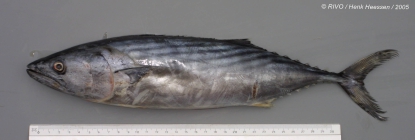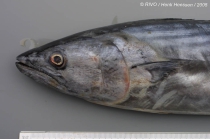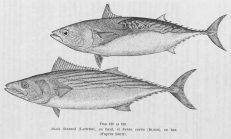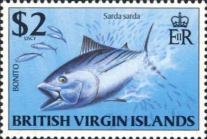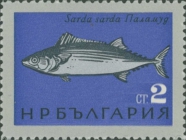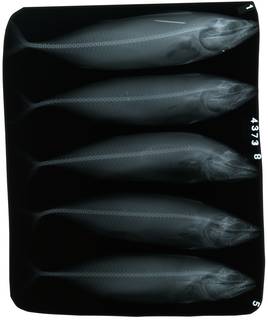Deep-Sea taxon details
Sarda sarda (Bloch, 1793)
127021 (urn:lsid:marinespecies.org:taxname:127021)
accepted
Species
Pelamys sarda (Bloch, 1793) · unaccepted
marine, brackish, fresh, terrestrial
(of ) Bloch, M. E. (1793). Naturgeschichte der ausländischen Fische. <em>Berlin.</em> v. 7: i-xiv + 1-144, Pls. 325-360. [Also a French edition, Ichthyologie, ou Histoire naturelle, générale et particulière des poissons, v. 10, published 1797.].
page(s): 44, Pl. 334 [details]
page(s): 44, Pl. 334 [details]
Description Occurs in water temperatures between 12° to 27°C and salinities between 14 and 39 0/00 S. Often forms schools near the...
Distribution Nova Scotia to Florida and northern Gulf of Mexico
Description Occurs in water temperatures between 12° to 27°C and salinities between 14 and 39 0/00 S. Often forms schools near the surface in inshore waters. Known to be cannibalistic, adults prey on small schooling fishes, invertebrates like squid and shrimps and can swallow relatively large prey. Utilized fresh, dried/salted, smoked, canned and frozen (Ref. 9987). [details]
Distribution Nova Scotia to Florida and northern Gulf of Mexico
Distribution Nova Scotia to Florida and northern Gulf of Mexico [details]
Froese, R. and D. Pauly. Editors. (2024). FishBase. Sarda sarda (Bloch, 1793). Accessed through: Glover, A.G.; Higgs, N.; Horton, T. (2024) World Register of Deep-Sea species (WoRDSS) at: https://www.marinespecies.org/DeepSea/aphia.php?p=taxdetails&id=127021 on 2024-04-24
Glover, A.G.; Higgs, N.; Horton, T. (2024). World Register of Deep-Sea species (WoRDSS). Sarda sarda (Bloch, 1793). Accessed at: https://www.marinespecies.org/deepsea/aphia.php?p=taxdetails&id=127021 on 2024-04-24
Date
action
by
original description
(of ) Bloch, M. E. (1793). Naturgeschichte der ausländischen Fische. <em>Berlin.</em> v. 7: i-xiv + 1-144, Pls. 325-360. [Also a French edition, Ichthyologie, ou Histoire naturelle, générale et particulière des poissons, v. 10, published 1797.].
page(s): 44, Pl. 334 [details]
context source (Deepsea) Intergovernmental Oceanographic Commission (IOC) of UNESCO. The Ocean Biogeographic Information System (OBIS), available online at http://www.iobis.org/ [details]
context source (Bermuda) Smith-Vaniz, W. F.; Collette, B. B.; Luckhurst, B. E (1999). Fishes of Bermuda: History, zoogeography, annotated checklist, and identification keys (American Society of Ichthyologists and Herpetologists - Special Publication No.4) . ASIH, 424 pp. [details]
basis of record van der Land, J.; Costello, M.J.; Zavodnik, D.; Santos, R.S.; Porteiro, F.M.; Bailly, N.; Eschmeyer, W.N.; Froese, R. (2001). Pisces, <B><I>in</I></B>: Costello, M.J. <i>et al.</i> (Ed.) (2001). <i>European register of marine species: a check-list of the marine species in Europe and a bibliography of guides to their identification. Collection Patrimoines Naturels,</i> 50: pp. 357-374 (look up in IMIS) [details]
additional source Scott, W.B.; Scott, M.G. (1988). Atlantic fishes of Canada. <em>Canadian Bulletin of Fisheries and Aquatic Sciences.</em> No. 219. 731 pp. [details]
additional source Muller, Y. (2004). Faune et flore du littoral du Nord, du Pas-de-Calais et de la Belgique: inventaire. [Coastal fauna and flora of the Nord, Pas-de-Calais and Belgium: inventory]. <em>Commission Régionale de Biologie Région Nord Pas-de-Calais: France.</em> 307 pp., available online at http://www.vliz.be/imisdocs/publications/145561.pdf [details]
additional source McEachran, J. D. (2009). Fishes (Vertebrata: Pisces) of the Gulf of Mexico, Pp. 1223–1316 in: Felder, D.L. and D.K. Camp (eds.), Gulf of Mexico–Origins, Waters, and Biota. Biodiversity. Texas A&M Press, College Station, Texas. [details]
additional source Bloch, M. E. (1793). Naturgeschichte der ausländischen Fische. <em>Berlin.</em> v. 7: i-xiv + 1-144, Pls. 325-360. [Also a French edition, Ichthyologie, ou Histoire naturelle, générale et particulière des poissons, v. 10, published 1797.].
page(s): 44 [details]
additional source Wheeler, A. (1992). A list of the common and scientific names of fishes of the British Isles. <i>J. Fish Biol. 41(Suppl. A)</i>: 1-37 (look up in IMIS)
page(s): 44 [details]
additional source Froese, R. & D. Pauly (Editors). (2023). FishBase. World Wide Web electronic publication. version (02/2023)., available online at https://www.fishbase.org [details]
ecology source Looby, A.; Erbe, C.; Bravo, S.; Cox, K.; Davies, H. L.; Di Iorio, L.; Jézéquel, Y.; Juanes, F.; Martin, C. W.; Mooney, T. A.; Radford, C.; Reynolds, L. K.; Rice, A. N.; Riera, A.; Rountree, R.; Spriel, B.; Stanley, J.; Vela, S.; Parsons, M. J. G. (2023). Global inventory of species categorized by known underwater sonifery. <em>Scientific Data.</em> 10(1). (look up in IMIS), available online at https://doi.org/10.1038/s41597-023-02745-4 [details]
page(s): 44, Pl. 334 [details]
context source (Deepsea) Intergovernmental Oceanographic Commission (IOC) of UNESCO. The Ocean Biogeographic Information System (OBIS), available online at http://www.iobis.org/ [details]
context source (Bermuda) Smith-Vaniz, W. F.; Collette, B. B.; Luckhurst, B. E (1999). Fishes of Bermuda: History, zoogeography, annotated checklist, and identification keys (American Society of Ichthyologists and Herpetologists - Special Publication No.4) . ASIH, 424 pp. [details]
basis of record van der Land, J.; Costello, M.J.; Zavodnik, D.; Santos, R.S.; Porteiro, F.M.; Bailly, N.; Eschmeyer, W.N.; Froese, R. (2001). Pisces, <B><I>in</I></B>: Costello, M.J. <i>et al.</i> (Ed.) (2001). <i>European register of marine species: a check-list of the marine species in Europe and a bibliography of guides to their identification. Collection Patrimoines Naturels,</i> 50: pp. 357-374 (look up in IMIS) [details]
additional source Scott, W.B.; Scott, M.G. (1988). Atlantic fishes of Canada. <em>Canadian Bulletin of Fisheries and Aquatic Sciences.</em> No. 219. 731 pp. [details]
additional source Muller, Y. (2004). Faune et flore du littoral du Nord, du Pas-de-Calais et de la Belgique: inventaire. [Coastal fauna and flora of the Nord, Pas-de-Calais and Belgium: inventory]. <em>Commission Régionale de Biologie Région Nord Pas-de-Calais: France.</em> 307 pp., available online at http://www.vliz.be/imisdocs/publications/145561.pdf [details]
additional source McEachran, J. D. (2009). Fishes (Vertebrata: Pisces) of the Gulf of Mexico, Pp. 1223–1316 in: Felder, D.L. and D.K. Camp (eds.), Gulf of Mexico–Origins, Waters, and Biota. Biodiversity. Texas A&M Press, College Station, Texas. [details]
additional source Bloch, M. E. (1793). Naturgeschichte der ausländischen Fische. <em>Berlin.</em> v. 7: i-xiv + 1-144, Pls. 325-360. [Also a French edition, Ichthyologie, ou Histoire naturelle, générale et particulière des poissons, v. 10, published 1797.].
page(s): 44 [details]
additional source Wheeler, A. (1992). A list of the common and scientific names of fishes of the British Isles. <i>J. Fish Biol. 41(Suppl. A)</i>: 1-37 (look up in IMIS)
page(s): 44 [details]
additional source Froese, R. & D. Pauly (Editors). (2023). FishBase. World Wide Web electronic publication. version (02/2023)., available online at https://www.fishbase.org [details]
ecology source Looby, A.; Erbe, C.; Bravo, S.; Cox, K.; Davies, H. L.; Di Iorio, L.; Jézéquel, Y.; Juanes, F.; Martin, C. W.; Mooney, T. A.; Radford, C.; Reynolds, L. K.; Rice, A. N.; Riera, A.; Rountree, R.; Spriel, B.; Stanley, J.; Vela, S.; Parsons, M. J. G. (2023). Global inventory of species categorized by known underwater sonifery. <em>Scientific Data.</em> 10(1). (look up in IMIS), available online at https://doi.org/10.1038/s41597-023-02745-4 [details]
 Present
Present  Inaccurate
Inaccurate  Introduced: alien
Introduced: alien  Containing type locality
Containing type locality
From other sources
Description Occurs in water temperatures between 12° to 27°C and salinities between 14 and 39 0/00 S. Often forms schools near the surface in inshore waters. Known to be cannibalistic, adults prey on small schooling fishes, invertebrates like squid and shrimps and can swallow relatively large prey. Utilized fresh, dried/salted, smoked, canned and frozen (Ref. 9987). [details]Diet Feeds on fishes and invertebrates including squids and shrimps, cannibalistic [details]
Distribution Nova Scotia to Florida and northern Gulf of Mexico [details]
Habitat Pelagic species, found at depths of 80- 200 m, may enter estuaries. [details]
Habitat nektonic [details]
Habitat Known from seamounts and knolls [details]
Importance Social- Highly commercial, gamefish [details]
Predators Wahoo, cannibalism [details]
Remark Type species of genus <111>. Authority (Cuvier & Valenciennes, 1831) in <130>. [details]
Reproduction External fertilization, open water/ Substratum egg scatterers [details]
| Language | Name | |
|---|---|---|
| Albanian | palamitipalamidi | [details] |
| Basque | lanpo haginzorrotzegalushe | [details] |
| Catalan | bonítol | [details] |
| Danish | rygstribet pelamide | [details] |
| Dutch | bonitoAtlantische bonitoAtlantische boniter | [details] |
| English | bonitoAtlantic bonito | [details] |
| Finnish | sarda | [details] |
| French | pélamidebonite à dos rayébonite à dos rayé | [details] |
| Galician | bonito | [details] |
| German | unechter BonitoPelamideAtlantischer Pelamide | [details] |
| Hebrew | בוניטו אטלנטי | [details] |
| Italian | pelamidapalamita | [details] |
| Modern Greek (1453-) | Παλαμίδα | [details] |
| Norwegian | stripet pelamide | [details] |
| Norwegian Bokmål | stripet pelamide | [details] |
| Norwegian Nynorsk | stripa pelamide | [details] |
| Portuguese | serrajãoserrasardabonito | [details] |
| Russian | Пеламида атлантическая | [details] |
| Spanish | bonito del Atlánticobonito atlánticobonito | [details] |
| Swedish | ryggstrimmig pelamid | [details] |
| Turkish | palamut | [details] |
| Ukrainian | Пеламіда атлантична | [details] |
To Barcode of Life (85 barcodes)
To Biodiversity Heritage Library (186 publications)
To Biodiversity Heritage Library (276 publications) (from synonym Pelamys sarda (Bloch, 1793))
To Dyntaxa
To European Nucleotide Archive (ENA)
To FAO Species fact sheets
To FishBase
To FishBase (from synonym Pelamys sarda (Bloch, 1793))
To FishBase images (Sarda sarda, Madeira Is., by Wirtz, P.)
To GenBank (310 nucleotides; 149 proteins)
To Global Biotic Interactions (GloBI)
To IUCN Red List (Least Concern)
To NMNH Extant Collection (Sarda sarda RAD111691-001)
To NMNH Extant Collection (Sarda sarda RAD111691-001)
To PESI
To ITIS
To Biodiversity Heritage Library (186 publications)
To Biodiversity Heritage Library (276 publications) (from synonym Pelamys sarda (Bloch, 1793))
To Dyntaxa
To European Nucleotide Archive (ENA)
To FAO Species fact sheets
To FishBase
To FishBase (from synonym Pelamys sarda (Bloch, 1793))
To FishBase images (Sarda sarda, Madeira Is., by Wirtz, P.)
To GenBank (310 nucleotides; 149 proteins)
To Global Biotic Interactions (GloBI)
To IUCN Red List (Least Concern)
To NMNH Extant Collection (Sarda sarda RAD111691-001)
To NMNH Extant Collection (Sarda sarda RAD111691-001)
To PESI
To ITIS


